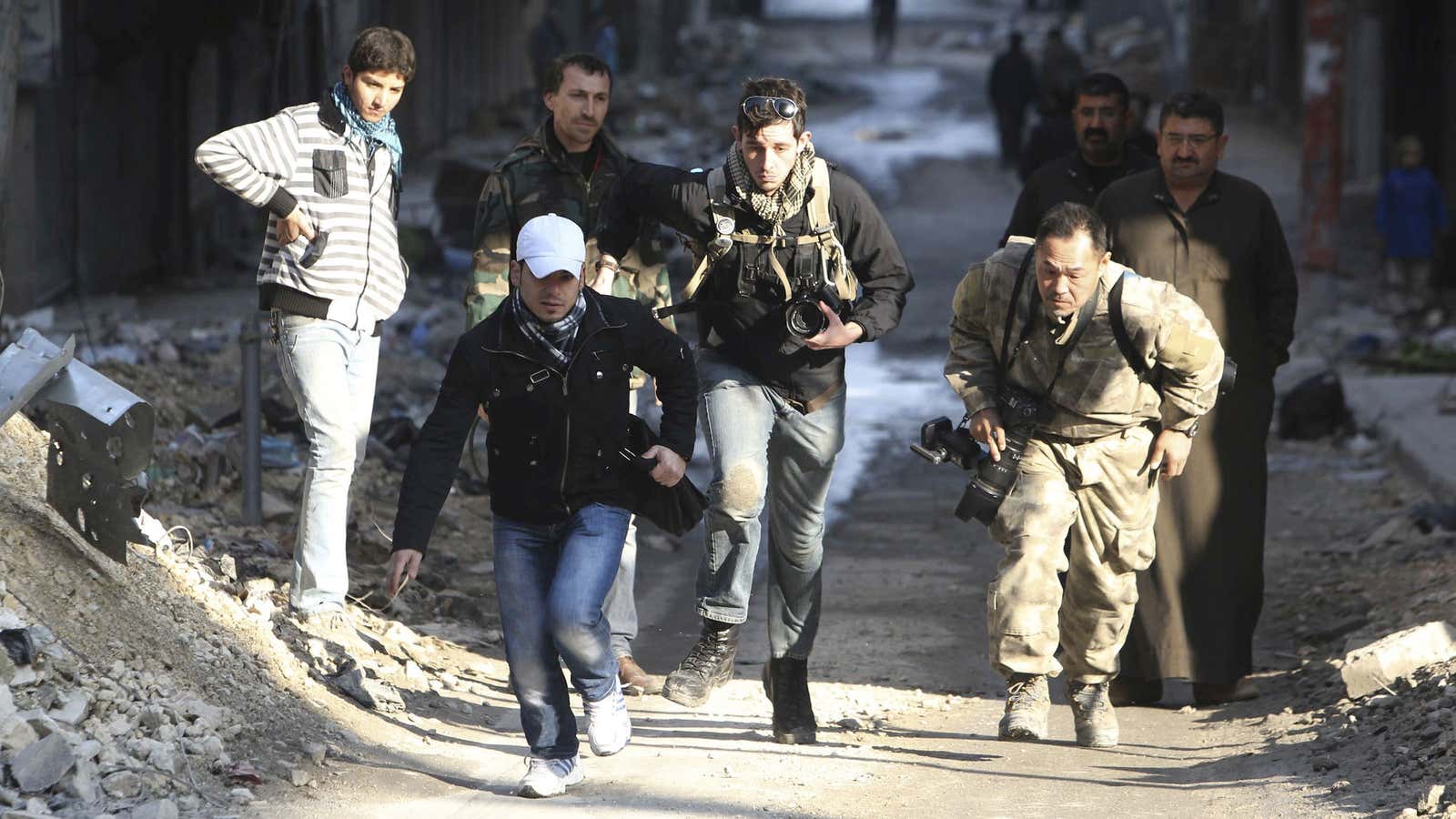Thirty journalists—half of them foreign reporters, half of them Syrian—have been kidnapped or gone missing in Syria, the Associated Press reported this week. The number is unprecedented. Syria today is the scene of the single largest wave of kidnappings in modern journalism, more than in Iraq during the 2000s or Lebanon during the 1980s. A combination of criminality, jihadism and chaos is bringing on-the-ground coverage of the war to a halt.
In one of several alarming new trends that has emerged in Syria, jihadists are abducting reporters, holding them captive and making no demands for their release. Instead of requesting prisoner exchanges or ransoms, they hold journalists indefinitely as human bargaining chips for future use.
Matthew Schrier, a 35-year-old freelance American photographer abducted in Syria last December, said that his captors made no demands before he escaped after seven months in captivity. Instead, they asked for his online passwords and used his credit cards to buy Mercedes-Benz parts, Ray-Ban sunglasses, tablets and laptops.
They also sent false email messages to Schrier’s family and friends that said he was safe and still working in Syria. His mother realized that the messages — filled with spelling and grammatical errors –were fake and agonized over what to do. Schrier urged the families of the missing to not give up.
“Until someone shows you proof that your loved one is dead, you have to assume they’re alive,” Schrier said in an email. “A lot of people who knew about me thought I was dead — and look what happened.”
The wave of kidnappings is also exposing an unintended consequence of a tactic widely used in Iraq and Afghanistan: media blackouts in kidnapping cases. Security experts and law enforcement officials generally recommend that abductions be kept secret in the hope that victims can be rapidly found or terms quickly reached. Publicity can also inflate kidnappers’ ransom expectations.
Of the 30 cases in Syria, the families of a dozen captives requested that the abductions be kept secret or could not be reached, according to the Committee to Protect Journalists. In an effort to warn other journalists about how dire the situation has become in Syria, the group took the unusual step of disclosing the total numbers of kidnappings in Syria but withheld the captives’ names and nationalities .
“Blackouts can have an unintended consequence of camouflaging the actual dangers of the situation,” Rob Mahoney, the committee’s deputy director, told me Friday. “It was in the interest of everyone that the scale of the problem be demonstrated.”
Others argue that keeping kidnappings secret decreases pressure on governments. Without demands for action from the public, government officials have no need to act.
Four American journalists are being held captive or missing in Syria. Austin Tice, a freelancer for the Washington Post, went missing near Damascus in August, 2012. James Foley, a freelance reporter for GlobalPost, went missing in northern Syria last November. The families of two other Americans have reportedly requested that their cases be kept secret.
(In 2008, two Afghan colleagues and I were abducted by the Taliban and held captive in Afghanistan and Pakistan for seven months. My family and my employer, the New York Times, requested a media blackout. )
As reporting has grown more treacherous, technological change has made it easier for freelancers to shoots videos and photographs and instantly file them to news agencies. But freelancers, if they are abducted, lack the backing of large news organizations that can hire security consultants and take other steps to aid captives’ families.
In an effort to discourage freelancers from entering Syria, the Sunday Times of Londonannounced in February that it would stop accepting photographs from freelancers who entered the country without a pre-arranged assignment with the newspaper. The paper had already suffered a tragic loss — its award-winning American correspondent, Marie Colvin, died covering the siege of Homs last year.
Some other news organizations are quietly implementing the same ban but it is not clear how many. Citing safety concerns, a Reuters spokesperson declined to publicly describe the methods the news organization uses to cover Syria.
In one positive sign, the journalist death toll so far in Syria this year stands at 18, a drop from the 31 who perished last year. Iraq, where at least 150 journalists died between 2003 and 2011, remains the deadliest conflict in modern journalism, claiming more reporters and photographers than Bosnia, Vietnam or World War II. In another disturbing new trend, two-thirds of those killed in Iraq did not die in combat, according to CPJ. They perished in targeted assassinations that were direct retaliation for their reporting.
In recent months, abductions have slowed inside Syria. But observers caution that many major news organizations have stopped sending reporters into Syria.
“It may only mean that fewer journalists are venturing in,” Mahoney said. “What that means is that there are fewer eyes and ears on the ground to bring out the horrors of the civil war for the Syrian people.”
Throughout history, journalists have been expected to take risks. Our job is to bear witness to injustice and suffering. In Syria, neither is happening. The agony of average Syrians trapped between the government and jihadis continues. And it is now easier for the world to ignore it.
This story was originally published by Reuters. More:
∙ Yellen vs. the Fed critics
∙ Your ‘exclusive’ interview isn’t
∙ Hooray for inflation
